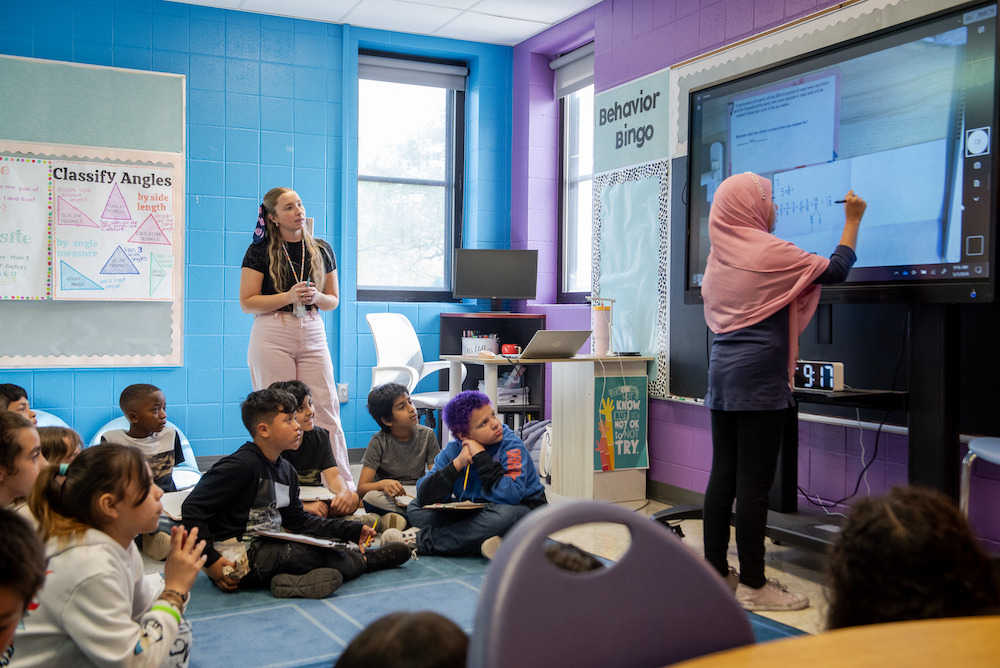
Q&A: Best Practices for Successful Curriculum Implementation
During a recent webinar, Emily Freitag, chief executive officer, and Aisley Adams, director of instructional support, answered educators’ questions about best practices for adopting and implementing high-quality instructional materials (HQIM).
The questions and answers from the session are compiled below—covering everything from HQIM selection timelines to protocols for unit internalization.
Q: In your experience, what is the ideal timeline for curriculum review, selection, and adoption? In other words, what is the right amount of time that allows for a thoughtful, thorough process that leads to effective implementation?
EF: Any process that doesn’t allow you to engage teachers is too fast. And any process that doesn’t allow you to make sure you’re clear on your vision for instruction before you start looking at samples is too fast.
However, processes that drag on for too long have risks as well because the decisions can get overworked. A lot of districts have learned that they just don’t want to review everything. They want to have a committee of people that pre-screen materials—whether they’re looking at state resources or EdReports—to narrow their list down to two or three options before bringing people in to discuss and compare curricula.
I think what really matters is how much time you have after you’ve made the selection but before teachers start teaching it. Generally, we tend to see that when people know what curriculum they’re going to be using the following year by April, they can do the necessary preparation and planning across April, May, June, and then support the training in July and August. (I’m in Nashville, so this is based on a southern schedule.) So, if you make a selection several months prior to training, you’re more likely to have time for planning and procurement before you begin training teachers.
How do you support districts to address competing priorities and initiatives alongside HQIM implementation?
AA: We often advise that “less is best” during HQIM implementation. The goal is to not overwhelm teachers and leaders by taking on too many initiatives at once. Instead, we focus on bite-sized initiatives or changes that are in alignment to the vision for instruction. Remember, your vision should be the North Star in instructional decision making. You can then anchor initiatives to specific implementation goals so that everyone can understand the connections and not feel as if they are asked to do a multitude of competing tasks. Additionally, providing intentional PL to support any new initiatives—along with open communication and collaboration—can help alleviate some of the angst stakeholders may feel when multiple initiatives are in place.
What are the elements of a successful unit launch session? And how have you seen districts accommodate teachers with different pacing challenges?
EF: I’ve made the controversial statement in the past that I would trade a weekly PLC for a half-day internalization session before each unit, and I stand by that claim. Since we first did the study that led to the Curriculum Support Guide, we’ve found that many critical instructional decisions happen at the unit level. It’s so important to understand, What is the arc of learning? What are the key moments that I can’t miss because they’re too important in building that learning? It’s easier to answer those questions at a unit level.
The key elements of a unit launch are going to be in the weeds of that particular unit, but they tend to involve some backwards planning. First, we dig into the end-of-unit assessment. Then, we look at pacing while considering the knowledge that different students are bringing and where we might need to spend more time within the unit. The Unit Internalization Leadership Tool from our Professional Learning Conditions and Practices can help you and your teachers study a unit to deeply understand the key components of your curriculum.
How should we address teachers wanting to use supplemental materials or software rather than the curriculum—especially when the materials are not vetted?
EF: We could spend an hour on just this topic, and, honestly, I think AI is going to make this even more of a challenge. But, I would say the unit study is where to have those conversations. You can say, “Let’s get clear on the end of the unit assessment we’re driving towards. As we think about this unit, what supplemental materials would you want to pull in? How do those materials support the learning of the unit?”
It’s also important to include special education, MTSS, and RTI educators on your implementation support team, because if they are not well versed with the curriculum, then their recommendations around what kind of interventions kids need may not align with the actual materials.
How do you advise and support districts that don’t have certain conditions or structures in place needed for effective implementation? Things like recurring common planning time for teachers or instructional support roles (i.e., when the principal is the only instructional leader in the building and they have too much on their plate)?
EF: I’m heartbroken by this question because I know how many people and schools this is true for. However, we know that every school community has assets that can be used to support effective curriculum implementation. We work with a lot of schools where a principal and teachers lead this work. Many schools have found really creative ways to think about teacher leaders and the roles that they can play in supporting implementation.
We know leaders are stretched in so many directions right now, and as a sole instructional leader, it can be daunting to feel like you have to support so many teachers in different grades using these very detailed curricula. But, familiarizing yourself with the materials will help you know where you can then use the curriculum to be supportive. Often, you’ll either spend some time on the front end studying the curriculum, or you’re going to end up having to spend time on the back end solving implementation challenges. So it’s not really a question of, “Are you going to have to spend time digging into the materials?” It’s “When and in what way do you want to do that?”
Many teachers seek a step-by-step curriculum, yet with active learning methods like project-based learning, relying solely on textbook content can be limiting. Do you have any strategies for supporting teachers who only want to work with traditional textbooks?
AA: While textbooks are a viable resource, they do have their limitations as it relates to student learning and the classroom environment. We often encourage teachers who are deeply tied to the textbook to be intentional around providing students with real-world examples, engaging activities, and peer discussions.
This question really speaks to the need for teachers to understand and experience the materials via a curriculum or unit study. To support the shift from traditional textbooks, it’s important to be very clear on the experiences we want students to have in the classroom and how the curriculum supports those experiences. This is why it’s so important to develop and communicate clear expectations of use when implementing a new curriculum.
Do you have any words of wisdom for piloting programs?
AA: Pilots are an optional step in the selection process, but they can be helpful for better understanding the materials and gaining investment across the system. The resource Guidance on Pilots and Selection provides overviews of pilot purposes and design considerations.
Piloting is a great opportunity to start on a small scale to uncover potential challenges. A pilot will inevitably surface many questions—make sure you have a way of logging all the questions that come up because the trends lifted from the pilot can be helpful when planning for full implementation.
Pilots should be driven by clear objectives so everyone is on the same page. Setting up the pilot with a clear sense of what you’re looking to learn and how you will test the materials gives teachers a starting point to organize their trial. Involving stakeholders in this process to gain insight and developing clear communication is essential to a successful pilot. Throughout the pilot, celebrate the wins and embrace the opportunities while also creating a plan for sustainability of the successful aspects of the pilot.
Do you have any advice for HQIM implementation in high school math?
EF: Many of the same implementation challenges that we’ve discussed are going to be the things that come up for high school math. However, I think the thing that’s different is the traditional attitude towards autonomy of instructional design.
AA: I agree, high school presents a challenge in shifting the mindsets around high-quality instructional materials. Change can lead to a lot of hesitation and resistance, especially when teachers are not sure that they will be supported. We’ve found that it’s really important to help high school teachers to understand the reasoning behind the shift and to give them the time and opportunity to deeply understand the new curriculum. We’re becoming a broken record here, but doing a unit study can sometimes cut to the chase of the conversations in a different way. Leaders can say, “Let’s all just look at a unit together. And then we’ll talk about what’s coming up as we go.” Sometimes there are incorrect assumptions that are at play about what the curriculum is going to look like or include.
Visit the Curriculum Support Guide for more free guidance and resources to support HQIM selection and implementation.


